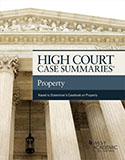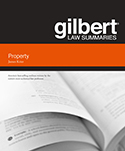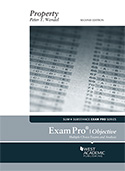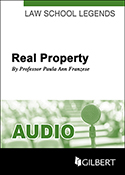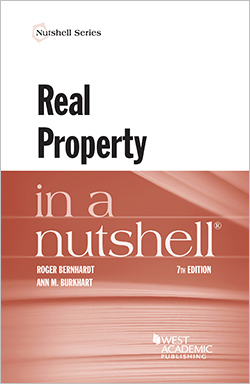
Real Property in a Nutshell
Authors:
Bernhardt, Roger H. / Burkhart, Ann M.
Edition:
7th
Copyright Date:
2016
21 chapters
have results for real estate
Chapter 17. Fixtures 15 results (showing 5 best matches)
- A real estate mortgage generally encumbers the mortgagor’s real property, but not his personal property. Therefore, a foreclosure sale transfers title to personal property assets that have become fixtures.
- A contract for the sale of real estate obligates the seller to convey all real property, but not personal property, to the buyer. Whether the contract includes items such as wall-to-wall carpeting and window blinds depends on whether they are fixtures. The contract should include an express provision concerning these types of items to avoid disputes. The contract also can specify that the seller will transfer title to items of personal property, such as the appliances.
- The person who owns and annexes personal property to real property may not own the real property. If the item becomes a fixture, title to it passes from the annexor to the real property owner despite the annexor’s subjective intent to the contrary.
- A fixture is personal property that has become so connected with real property as to become part of it. To be a fixture, the object must retain its original identity even after being affixed to the real property.
- Courts consider a number of factors in determining whether to classify an item as a fixture: (1) the method of annexation (how firmly and securely the item is annexed to the real property), (2) appropriateness (how well the item has been adapted to the real property and how appropriately it fits), (3) removability (how much removal will harm the realty), and (4) intent (the annexor’s objective intent, as inferred from the above considerations and from his relationship to the real property, especially whether he owns it).
- Open Chapter
Chapter 2. Common Law Estates 138 results (showing 5 best matches)
- The present estates are classified according to duration. The estates described in this Chapter are the only ones that our common law recognizes. They can be created for real and personal property.
- A voluntarily created life estate is a “conventional” life estate (e.g. A conveys “to B for his life”). In contrast, a “legal” life estate is created by operation of law, such as the legally created marital property interests (e.g. dower and curtesy). When the life estate owner is the measuring life, it is an “ordinary” life estate. When someone other than the life estate owner is the measuring life, it is a life estate “pur autre vie.”
- The estate subject to condition subsequent exists only when, in the document that creates the estate, the grantor retains the future interest. The conveyance must use words of condition, such as “upon condition that,” “provided that,” or “but if,” to attach the condition to the words of purchase. Like determinable estates, these estates can end when the condition occurs. However, unlike the determinable estate, termination is at the election of the owner of the future interest, rather than automatic. Therefore, to decrease the possibility that an estate will be forfeited, ambiguous language is construed as an estate subject to condition subsequent, rather than as a determinable estate.
- The fee simple, fee tail, and life estate are called freehold estates. The tenancy for years and the periodic tenancy are nonfreehold estates. The need for distinguishing between freehold and nonfreehold estates derives from the common law concept of seisin. The holder of a freehold estate had seisin (i.e. was seised of the land), whereas the holder of a nonfreehold estate had possession but not seisin. In England, all land titles came from the monarch, either directly to the possessor or by way of intermediate lords. The holder of a freehold estate owed certain services to the overlord, somewhat equivalent to modern rent or property taxes. Today, seisin equates most closely with title to property.
- At early common law, a conveyance of a freehold estate that did not include the words “and heirs” or “and heirs of the body” was deemed to convey only a life estate. However, in virtually every jurisdiction today, the intent to convey only a life estate must be clear to overcome the modern presumption in favor of fee simple. Therefore, words such as “to Bob for his life” must be used to create a life estate. A life estate also is created if the estate necessarily will terminate when the measuring life dies. For example, “to Bob for so long as he farms the land” creates a life estate (a defeasible life estate), because the longest it can last is while Bob is alive.
- Open Chapter
Chapter 7. Real Estate Brokers 2 results
- A broker must be licensed by a state regulatory agency. To obtain a license, a broker must possess certain minimum academic credentials, such as some college education, must pass a qualifying exam, and must satisfy character and fitness requirements. The broker also may have to satisfy continuing education requirements and have a certain amount of experience in real estate marketing. Real estate salespersons hold inferior
- Property can be sold without a broker’s assistance, but the buyer and seller generally find it to be more convenient to have a broker assist them. Therefore, most real estate sales involve a broker. Unlike many other retail industries, the broker does not carry her own inventory. Rather than buying and selling land herself, she normally acts as an agent for the buyer or seller.
- Open Chapter
Chapter 8. Contract of Sale 6 results (showing 5 best matches)
- If the seller or buyer dies before closing, the sale still will be consummated. If the seller dies, because his interest in the land became personal property when the contract was signed, the people who inherit his personal property get the purchase price from the sale, but those who inherit his real property must execute the deed to the buyer. Similarly, if the seller married after contracting to sell the land and then died, the surviving spouse could not claim a marital interest because, when the marriage occurred, the seller held the legal title in trust for the buyer. Conversely, if the buyer dies, the purchase price is paid from the personal estate, and the people who inherit her real property will get the land.
- The common law implied no warranty of fitness. This basic rule generally still applies to real estate. However, sellers now often have greater disclosure duties, and commercial sellers may be subject to an implied warranty of fitness.
- build the home if the seller is a real estate developer, such as the developer of a subdivision. However, the warranty normally does not apply to builders that did not sell the property, such as the contractor that the developer employed.
- Every seller of real estate must disclose any material defect known to him and not reasonably discoverable by the buyer (latent defect). If the
- Sam and Barb signed a contract for the sale of Sam’s land. Barb then discovered that Sam has only a life estate in the land, rather than fee simple absolute. Barb is not obligated to purchase.
- Open Chapter
Chapter 4. Landlord and Tenant 26 results (showing 5 best matches)
- A lease assignment transfers the tenant’s rights under the lease to the assignee, which creates privity of estate between the landlord and assignee. Based on privity of estate, the landlord and assignee can enforce the real covenants in the lease against each other. Real covenants are covenants that directly affect the land or the tenancy. For that reason, they “run with the land.” If the lease includes any personal covenants (covenants that do not directly affect the land or the tenancy), the assignee is liable for them only if she “assumed”
- Tom has a lease with five years remaining in the term. He transfers the entire balance of the term to Ann. The assignment document provides that Tom may re-enter and terminate Ann’s estate if she fails to perform any lease obligation. In some states, this is treated as a sublease, because Tom retained a right of re-entry. Courts in other states more strictly follow the common law system of estates and hold that this is an assignment because the right of re-entry is not a common law estate. Thus, the entire estate has been transferred to Ann.
- In a tenancy for a term and a periodic tenancy, the tenant has an estate that continues for a certain length of time. The estate’s duration is unaffected by the tenant’s possession or failure to possess. The estate is possessory whether the tenant actually possesses. Consequently, even a nonpossessing tenant owes rent for the entire lease term.
- A tenant does not terminate the tenancy simply by failing to pay rent. Under the early common law doctrine that lease covenants are independent, the landlord could not terminate the estate merely because the tenant failed to perform the rent covenant. Today, a landlord generally may terminate the tenant’s estate for nonpayment of rent. However, nonpayment does not automatically terminate the estate. Termination requires the landlord’s affirmative act.
- Because the lease conveyed an estate in land to the tenant, the early common law provided that the estate could be terminated only by the tenant’s reconveyance to the landlord by a surrender deed. To solve the practical problems posed by the tenant’s abandonment, the courts created the fiction that the tenant’s abandonment constituted an offer to surrender the leasehold estate and that the landlord’s re-entry was an acceptance of that offer. In this way, the tenant’s estate was surrendered by operation of law, rather than by surrender deed.
- Open Chapter
Chapter 12. Mortgages 4 results
- Lenders often sell their mortgages in the “secondary mortgage market.” The mortgage purchasers create large pools of mortgages and sell fractional ownership interests in them or bonds secured by them. By purchasing mortgages from the originating lender (the lender who made the loan), the secondary market injects more funds into the real estate market.
- When real property was security for a loan during the early common law, the parties had to comply with the rules of conveyancing and estates in land. Because the law of future interests was more rigid then, extreme care was required. A borrower’s promise to convey his property to the lender if he
- Mortgages are recordable and are subject to the same priority principles that apply to other real property interests. A mortgage that qualifies for protection under the recording act from any other mortgage is referred to as a “senior” or “first” mortgage. Subsequent mortgages are called “junior” mortgages and are numbered according to their priority, such as second and third mortgages. In many states, a purchase money mortgage has special priority status.
- In response to that problem, lenders began using a recognized property interest, the fee simple subject to condition subsequent. The borrower executed an immediate conveyance of his property to the lender. The conveyance was subject to the condition that, if the borrower repaid the debt by the due date, the lender’s estate would terminate. Alternatively, lenders sometimes took a conveyance of the fee simple absolute and gave a covenant to reconvey upon timely payment of the debt. These arrangements gave the lender title to the land for the life of the loan, so that the borrower could not dispose of the land or otherwise impair the lender’s security. Furthermore, if the borrower failed to pay, the lender had the fee simple absolute title without the need for any judicial action.
- Open Chapter
Chapter 6. Real Covenants and Equitable Servitudes 24 results (showing 5 best matches)
- Ann covenanted with Bob that she would maintain his garden. This covenant does not satisfy the privity of estate requirement for a real covenant. Ann then sold her property to Cathy, who
- Ann covenanted with her neighbor, Bob, that she would not use her land in competition with his use of his land. This covenant does not satisfy the privity of estate requirement for a real covenant. Bob then sold his land to Cathy. If Ann and Bob intended that future owners of Bob’s lot could enforce Ann’s promise, Cathy probably can enforce it as an equitable servitude though the benefit does not touch and concern her land.
- Ann covenanted with her neighbor, Bob, that she would not use her land in competition with his use of his land. This covenant does not satisfy the privity of estate requirement for a real covenant. Ann then sold her property to Cathy, who knew about the covenant. In many jurisdictions, the covenant’s benefit is deemed not to touch and concern Bob’s land, although its burden touches and concerns Cathy’s land. Therefore, in England, the burden would not bind Cathy, even in equity. But, in the United States, Cathy probably would be bound by an equitable servitude.
- An interest “runs with the land” when it benefits or burdens subsequent owners. Thus, an appurtenant easement runs with the land because it burdens the servient estate even after it has been transferred and continues to benefit the dominant estate even after it has been transferred. Therefore, a landowner may have the right to walk across another’s land based on an easement between their predecessors in title, regardless of whether the current owners ratified it. In contrast, an in gross easement’s benefit cannot run with land because there is no dominant estate, but its burden can run with the servient estate.
- The owner of a defeasible estate owns her land subject to a condition, and she cannot convey the land free from that condition. In that sense, the condition on her estate runs with the land. However, the benefit of the condition is itself an interest in land and generally is transferable. It does not run with any other land.
- Open Chapter
Index 27 results (showing 5 best matches)
OUTLINE 41 results (showing 5 best matches)
Chapter 10. Priorities: The Recording System 10 results (showing 5 best matches)
- A few states’ statutes base priority on the order in which the documents were recorded. The subsequent grantee can prevail even if she knew about the prior conveyance. The sole question is which instrument was recorded first. These statutes protect subsequent grantees that are “fleet of foot.” Sometimes, these statutes are worded in terms of priority. In other cases, they achieve the same effect by making recordation part of the process of delivery, so that a deed will not pass title until it is recorded. For example, Maryland’s race statute provides: “[N]o estate of inheritance or freehold, declaration or limitation of use, estate above seven years, or deed may pass or take effect unless the deed granting it is executed and recorded.” Md. Code Ann., Real Prop. § 3–101 (a).
- Owen conveyed a life estate to Ann and the remainder to Bob. Ann took possession and recorded her deed. Bob conveyed his remainder interest to Ann, but this deed was not recorded. Later Bob conveyed his interest to Carol. Carol should prevail over Ann as to Bob’s remainder. Although Ann was in possession, the records indicated that she held a life estate. Therefore, her possession was consistent with the records and created no duty for Carol to ask Ann about her rights. Carol has a remainder after Ann’s life estate.
- In most Illustrations in this section, the transfers are of the entire estate, but the same priority principles generally apply to transfers of partial interests.
- Quasi-easements are created when a parcel of land is subdivided under circumstances that permit a court to infer that one parcel was intended to be burdened for the benefit of the other though an express easement was not created. The courts are divided whether a subsequent bona fide purchaser of the servient estate takes subject to the easement.
- Most states authorize a creditor who obtains a judgment to record it, which makes it a lien on all real property owned by the judgment debtor in the county where the judgment is recorded. If the creditor has attached any property before the judgment, the judgment lien relates back to the date of the attachment. Before the judgment, the attachment creates an attachment lien on the property. In most states, such lien creditors are not protected by the recording acts, because they have not obtained their liens in reliance on the records.
- Open Chapter
Chapter 5. Easements, Profits, and Licenses 36 results (showing 5 best matches)
- Recognition of an implied easement not only conveys a property interest to the dominant estate owner, it also takes an interest from the servient estate owner. Therefore, courts are reluctant to recognize an implied easement unless it serves a significant purpose. They require that the easement be necessary or beneficial to the owner of the prospective dominant estate.
- An appurtenant easement’s benefit is automatically transferred with the dominant estate even if it is not mentioned in the deed that transferred the estate. Thus, an appurtenant easement “runs with the land.” However, if the deed expressly provides that the easement is not transferred with the dominant estate, the easement normally is destroyed.
- An appurtenant easement benefits a particular parcel of land (the dominant estate or dominant tenement), even if title to the land is transferred after the easement is created. In contrast, an in gross easement benefits a particular individual regardless of whether she owns any land. The land that is subject to an appurtenant or in gross easement is called the servient estate or servient tenement.
- Three elements must be satisfied to imply an easement by necessity: (1) The dominant and servient estates were owned by the same person; (2) The need for an access easement was created by the subdivision of the commonly owned land; and (3) The easement is necessary to use the dominant estate.
- The dominant and servient estates must have been owned by the same person before the need for access to the dominant estate arose.
- Open Chapter
Chapter 1. Possession and Ownership 9 results (showing 5 best matches)
- Real property (realty) consists of land and objects that are permanently affixed to land, such as trees and buildings. Real property generally is immovable, whereas personal property (also known as personalty or chattel) consists of movable objects. Personal property can be tangible, such as a book or car, or intangible, such as an idea or the good will of a business. Property law largely consists of issues relating to real property, rather than to personal property. By and large, however, the rules are the same for both.
- “Actual” possession means no more than real possession. Its main function is as a counterpoint to constructive possession. By itself, constructive possession never ripens into title by adverse possession. An ejectment action lies only against real possessors.
- Paul is a squatter on Lot 1. He knows that he does not own Lot 1 but hopes that the real owner will not do anything about it. He intends to stay until evicted. Paul possesses, but does not own, Lot 1.
- Real title provides constructive possession without the need for actual possession. Thus, an absentee owner can eject wrongful possessors because his title provides constructive possession, which the trespassers have breached. The constructive possession claims of various parties may conflict. The following Illustrations demonstrate the resolutions of these conflicts.
- During Paul’s ten years on the property, others frequently intruded and were not ousted by Paul. Paul will not acquire title by adverse possession because his possession was not exclusive. This result also can be explained by saying that Paul was not in actual possession, because a “real” possessor does not tolerate intruders.
- Open Chapter
Chapter 3. Concurrent Ownership 8 results (showing 5 best matches)
- One cotenant cannot sever a tenancy by the entirety. A conveyance of such an estate is valid only if both spouses sign. A tenancy by the entirety ends when the cotenants divorce. Normally, the estate is converted into a tenancy in common to avoid the right of survivorship.
- B. PREFERENCE FOR ONE ESTATE OVER ANOTHER
- Tenants in common have separate, though undivided, interests in the property. Therefore, the interest of each is inheritable by her heirs or passes by will. A surviving tenant in common takes the entire estate only when she is the heir or devisee of the deceased.
- Alex and Chris were joint tenants. When Chris died. Wilma, his widow, was his only heir. Then Alex died without a will. Her son, Harry, was her only heir. Harry now owns the entire estate. Alex acquired the entire title by survivorship. At her death, Harry inherited her entire interest.
- Although a life tenant and the future interest holder may be viewed as sharing ownership of the same property, their ownership is divided in time. At no time do they share the same rights in the property. In contrast, concurrent owners own the same interest at the same time. Their ownership is not chronologically separated. Their ownership is “undivided” because each owner has the right to possess the entire property. Both real and personal property can be owned concurrently. A joint bank account is an example of the latter.
- Open Chapter
Chapter 9. Transfer of Title by Deed 10 results (showing 5 best matches)
- If the deed does not specify the estate being conveyed, it presumptively transfers fee simple absolute. The ancient words of limitation “and heirs” are no longer necessary. Therefore, if a lesser estate is intended, qualifying language must be added, such as “for ten years” or “for life.” Similarly, the deed should describe whether multiple grantees are taking as tenants in common, joint tenants, or tenants by the entirety. If the form of cotenancy is not specified, a tenancy in common normally is presumed, unless the parties are married, which, in some states, creates a presumption for a tenancy by the entirety. If the estate being conveyed is subject to encumbrances, such as an easement or covenant, the deed should specify them as exceptions to the title being conveyed.
- 4. Description of the Estate
- This covenant warrants that the grantor owns the estate that the deed is to convey. It is breached if the grantor does not own the land or owns a lesser interest.
- Grace delivered a warranty deed to Gene that purports to convey the fee simple absolute title. If Grace had only a life estate, she breached the covenant of seisin.
- This covenant is almost identical to the covenant of seisin but warrants that the grantor has the right to convey the estate described in the deed, rather than that she owns it.
- Open Chapter
Title Page 1 result
Chapter 18. Trespass 1 result
Halftitle Page 1 result
Chapter 16. Agreed Boundaries 1 result
Chapter 13. Airspace 1 result
- Len leases a second floor apartment in his building to Tina. Technically, Tina has a leasehold estate in airspace located approximately ten to twenty feet over the surface of Len’s land. If Tina enters any other second floor apartment without permission, she is trespassing into the airspace of the person entitled to possess it.
- Open Chapter
Chapter 20. Land Use Regulation 1 result
- The California Subdivision Map Act, Cal. Gov’t Code § 66479, provides: “There may be imposed by local ordinance a requirement that areas of real property be reserved for parks, recreational facilities, fire stations, libraries or other public uses.” Another section authorized dedication of land or payment of fees in lieu “for classroom and related facilities for elementary or high schools” where existing schools are overcrowded. Cal Gov’t Code § 65974.
- Open Chapter
Part 2. Conveyancing 1 result
- Part Two addresses problems incident to the transfer of interests in land. Landlord-tenant law could be regarded as a branch of conveyancing, because it involves the transfer of a leasehold estate from landlord to tenant. However, it has been treated as a separate topic because the problems involved in that context generally deal with the parties’ relations after the lease has been executed. The creation and transfer of easements also could be treated as a conveyancing topic. However, the conveyancing aspects of easements generally are incidental to other issues. Adverse possession is not a question of conveyancing at all, because the title acquired by the adverse possessor is an original title, rather than one conveyed by the former owner.
- Open Chapter
- Publication Date: November 20th, 2015
- ISBN: 9781634599207
- Subject: Property
- Series: Nutshells
- Type: Overviews
- Description: This concise work discusses most rules covered in real property casebooks. The text is divided into three sections. Part One provides an overview of property interests by covering lost v. mislaid v. abandoned property, adverse possession, gifts, common law estates, future interests, landlord-tenant law, concurrent ownership, marital property rights, easements, profits, licenses, real covenants, and equitable servitudes. Part Two covers conveyancing, including real estate brokers, contracts of sale, deeds, recording, title insurance, and mortgages. Part Three covers a variety of property rights and liabilities, including airspace, water rights, the right to support, agreed boundaries, fixtures, trespass, nuisance, and land use regulation.
